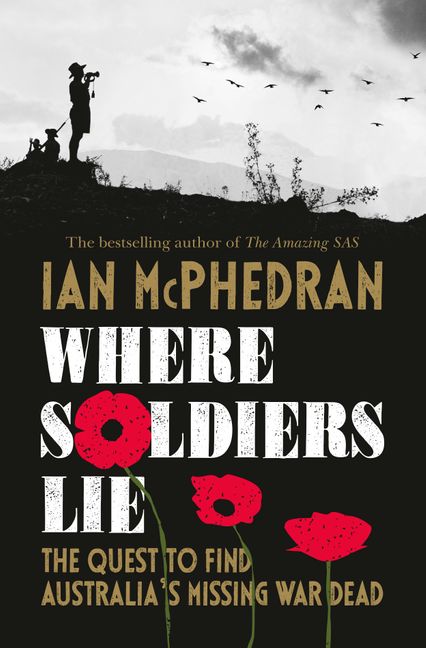Where Soldiers Lie is not a guidebook to Commonwealth War Graves where our soldiers are buried and commemorated.

Hardcover 288pp RRP $39.99
It is so much more! It is a fascinating insight into the search for our missing serviceman and women who have no known grave or headstone of their own.
The number of missing is extraordinary. Of about 102 000 servicemen and women who died in the service of this country since WWI, some 35 000 are listed as ‘Missing’, one in three! Some are lost at sea while others still lie in steamy jungles in Asia or in overseas War Graves recorded as simply ‘Known Unto God’.
The book is presented in three time periods: ‘Viet Nam to Korea, WWII and WWI. There is also a section devoted to ‘The Scientists’ describing their skills and technologies in support the searchers. This section is very informative as it describes the skills and technologies used that are more like police forensics.
More importantly, it is the story of dedicated and passionate men and women who take up the challenge to search for our missing. They research historical narratives, old reports, maps and diaries; investigate information, interview combatants of both sides and locals and finally conduct the field trips. However, their enthusiasm is not always matched by government support. This is clearly illustrated in the story of the search for the ‘Viet Nam Six’, the final account of our war dead from that conflict. Their story is a fitting opening chapter to this book.
There is also a chapter on the recovery of 250 dead from a mass grave at Fromelles, with many now identified and interred. There are other successful searches discussed and more yet to be done. The search for our missing is not simple and it is not made any easier with the passing of time.
Formal identification needs a high level of confidence in the result. The evidence of various experts; historians, archaeologists, forensic scientists, forensic dentists and DNA experts must align before a formal identification is made.
There are international sensitivities with searches, such as in locating 43 MIA Australians in the DMZ or in North Korea. Similarly, teams can’t go digging up farms in Belgium 100 years after the war unless there is compelling evidence to do so.
McPhedran explains very well why the searches are still necessary. It is a daunting task and while not all the missing will ever be found, it is important to relatives, their comrades and the nation that sent them to war, that the searches continue while there are still missing.
Government policy has changed over time for the better. During WWI and WWII, the dead were buried near the battlefield with their comrades. Even as late as 1966, the policy was for burial in theatre. Now we see ramp ceremonies and military funerals in their hometown. The Department of Defence has established Unrecovered War Casualties sections for the services and while they are enthusiastic in their duties, they are small teams but at least is a start.
This is an excellent read in an area that has not been well documented before, other than for individual cases. It is well written and easy to follow. There is some jargon and acronyms, but they are all well explained in the text and the glossary. Some 50 informative photographs include the search teams. I commend this book to military history enthusiasts as an explanation of a seldom discussed aspect of war service and to the general public to gain an understanding of why recovering our missing is so important.
Reviewed for RUSIV by Ian Lillie, March 2020
Contact Royal United Services Institute about this article.






